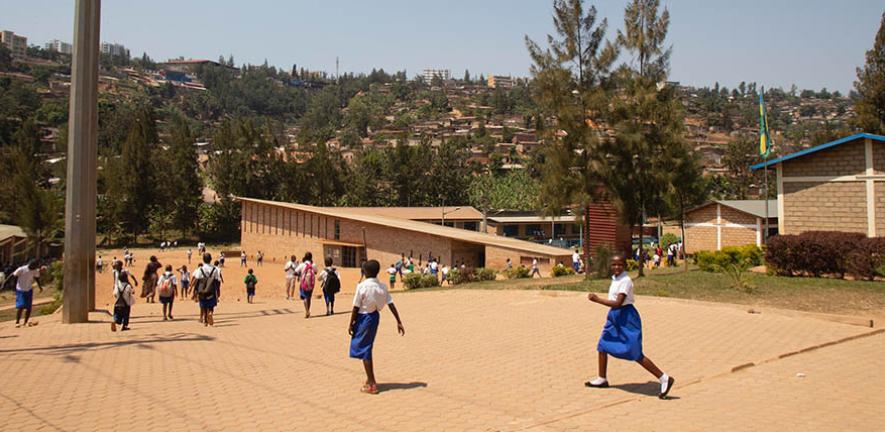
New data from Rwanda, and some of the first published on how COVID-19 has impacted school attendance in the Global South, suggest that a widely-predicted spike in drop-out rates has “not materialised”.
New data from Rwanda, and some of the first published on how COVID-19 has impacted school attendance in the Global South, suggest that a widely-predicted spike in drop-out rates has “not materialised”.
We are still developing a comprehensive picture of the situation across Sub-Saharan Africa, but the impact on drop-outs appears far less extreme than initially feared
Pauline Rose
Ever since the pandemic forced schools around the world to close, analysts, academics and teachers have been warning that many students in poorer countries might not return. According to some estimates, more than 10 million school-age students are at risk of dropping out worldwide. There have been particular concerns about marginalised groups such as the very poorest children and girls.
The new study, which used enrolment data from 358 Rwandan secondary schools, collected both before and after the closures, found that rather than undergoing a sharp fall, student numbers actually rose when schools reopened. The cause appears to have been a combination of existing students returning, and the enrolment of other pupils who were out of school before the pandemic began.
Researchers say that this may represent an emerging trend, because as-yet unpublished results from other sub-Saharan countries, such as Ethiopia and Malawi, similarly show no steep fall in numbers.
Despite this, a more gradual, long-term decline in the numbers of children in school may be underway. The research tracked enrolment past the point where schools reopened in Rwanda, and up to May 2021. By that stage, some students did appear to be dropping out of the system. This was particularly true of those from marginalised groups.
The research was undertaken by a team from the University of Cambridge and the East African research and data collection firm, Laterite, and was carried out for the Mastercard Foundation’s Leaders in Teaching Initiative.
Professor Pauline Rose, Director of the Research for Equitable Access and Learning (REAL) Centre, at the Faculty of Education, University of Cambridge, said: “Given the seriousness of the impact of COVID-19, I wouldn’t have been surprised if enrolment rates had halved when schools reopened. We are still developing a comprehensive picture of the situation across Sub-Saharan Africa, but the impact on drop-outs appears far less extreme than initially feared.”
“It is important we continue to monitor the situation. There was clearly real enthusiasm for schools to reopen at first, but there are now signs that some children may potentially be disappearing from the system.”
Schools in Rwanda closed in March 2020 and did not reopen until November, when they did so on a staggered basis. The research collected aggregate enrolment data from before the pandemic, in February 2020, and a year later, in February 2021.
This showed that after schools reopened, enrolment rates rose in the Secondary 1 and Secondary 4 year groups: natural entry points into the Rwandan system because they mark the start of lower and upper secondary school respectively. Enrolment rose by 7% at the Secondary 1 level, and 11% at Secondary 4, in February 2021. Numbers remained steady in the other year groups.
Crucially, the Rwanda Basic Education Board decided to make all students return to the year group that they were previously in when schools reopened. This means that the Secondary 1 and 4 year groups comprised the same cohorts across 2020 and 2021. The rise in numbers was therefore almost certainly due to students who had previously dropped out re-joining their cohort in February 2021.
The study also gathered both enrolment and assessment data from a sample of 2,800 students in the Secondary 3 year group, which it followed up to May 2021.
By that stage, researchers found, some students had started to drop out. About 89% of the entire sample group were still in school by May 2021, but the figure was lower among girls, and particularly among students who were over the ‘expected’ cohort age because they had been kept back an additional year or more. The overage group were also disproportionately likely to come from less-wealthy backgrounds.
“Keeping track of these children is really important,” Mico Rudasingwa, Research Associate at Laterite said. “By the time they reach adolescence, those from the poorest backgrounds in particular are in danger of dropping out early to support with income generating activities for the household.”
The sample group of students also took a learning assessment, in the form of a numeracy test, in February 2020, and again in May 2021 – two terms after their return to school. The results were measured using a ‘latent ability score’ – given as a figure between 0 and 1 – which takes into account not only how many questions they got right, but how difficult those questions were. The average score rose from 0.47 in the first test to 0.52 in the second. Over 90% of the schools in the sample group recorded an average improvement in numeracy scores.
Although positive, these results should be treated with caution, as there is no counterfactual evidence available about how much their test results might have improved had the school closures never occurred. The learning levels of some groups also improved more than others. Boys generally outperformed girls by about 0.02 points on the latent ability scale, while overage students again lagged behind their peers, by about 0.03 points.
The study also collected teacher retention data by tracking 1,700 teachers in science, technology, engineering and maths (STEM) subjects before and after the closures. Around 94% of STEM teachers returned to their classes in early 2021, and almost half the schools surveyed saw an overall increase in STEM teachers through new recruitment. The report describes this low turnover rate as ‘encouraging’.
The full report is available on the REAL Centre website.

The text in this work is licensed under a Creative Commons Attribution 4.0 International License. Images, including our videos, are Copyright ©University of Cambridge and licensors/contributors as identified. All rights reserved. We make our image and video content available in a number of ways – as here, on our main website under its Terms and conditions, and on a range of channels including social media that permit your use and sharing of our content under their respective Terms.




